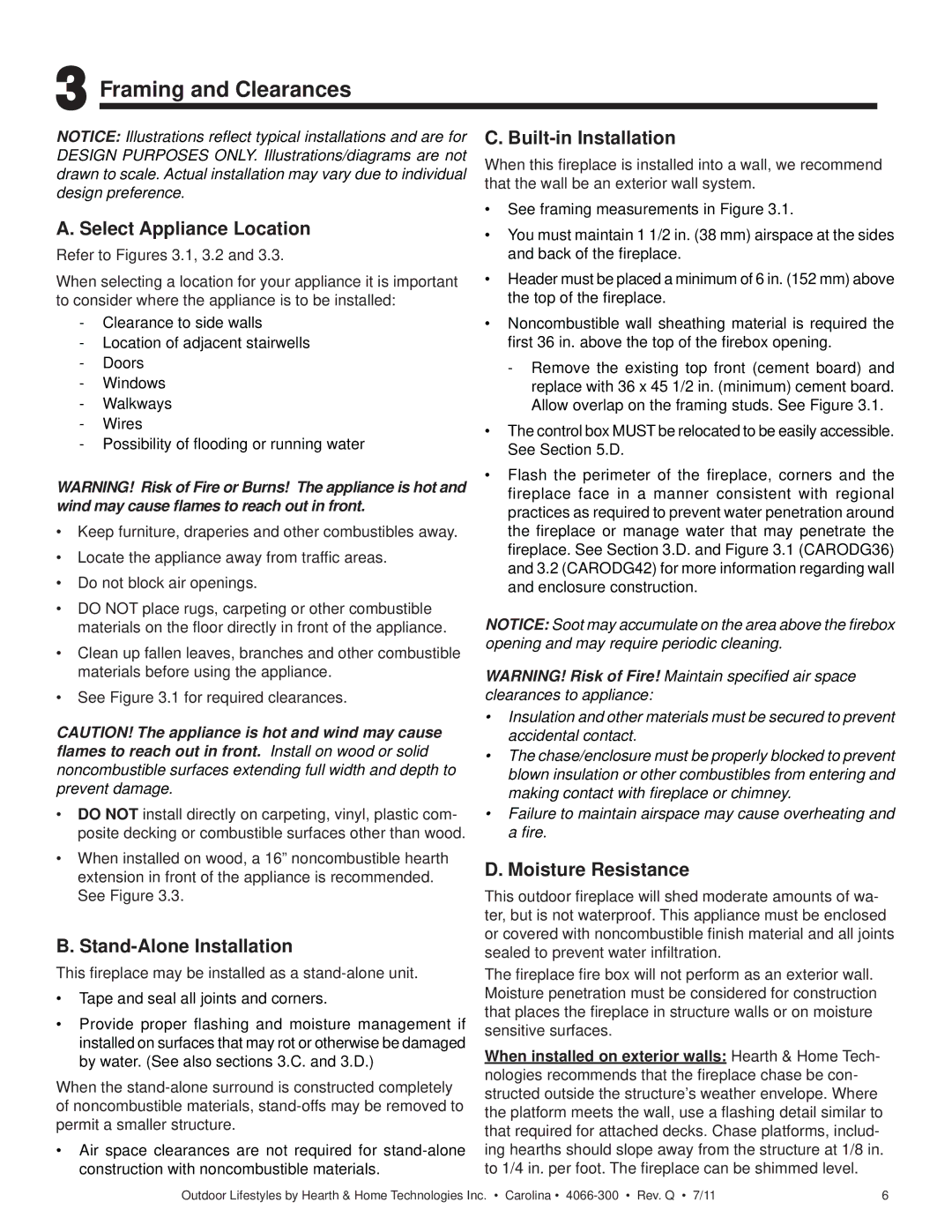3 Framing and Clearances
NOTICE: Illustrations reflect typical installations and are for DESIGN PURPOSES ONLY. Illustrations/diagrams are not drawn to scale. Actual installation may vary due to individual design preference.
A. Select Appliance Location
Refer to Figures 3.1, 3.2 and 3.3.
When selecting a location for your appliance it is important to consider where the appliance is to be installed:
-Clearance to side walls
-Location of adjacent stairwells
-Doors
-Windows
-Walkways
-Wires
-Possibility of flooding or running water
WARNING! Risk of Fire or Burns! The appliance is hot and wind may cause flames to reach out in front.
•Keep furniture, draperies and other combustibles away.
•Locate the appliance away from traffic areas.
•Do not block air openings.
•DO NOT place rugs, carpeting or other combustible materials on the floor directly in front of the appliance.
•Clean up fallen leaves, branches and other combustible materials before using the appliance.
•See Figure 3.1 for required clearances.
CAUTION! The appliance is hot and wind may cause flames to reach out in front. Install on wood or solid noncombustible surfaces extending full width and depth to prevent damage.
•DO NOT install directly on carpeting, vinyl, plastic com- posite decking or combustible surfaces other than wood.
•When installed on wood, a 16” noncombustible hearth extension in front of the appliance is recommended. See Figure 3.3.
B. Stand-Alone Installation
This fireplace may be installed as a stand-alone unit.
•Tape and seal all joints and corners.
•Provide proper flashing and moisture management if installed on surfaces that may rot or otherwise be damaged by water. (See also sections 3.C. and 3.D.)
When the
•Air space clearances are not required for
C. Built-in Installation
When this fireplace is installed into a wall, we recommend that the wall be an exterior wall system.
•See framing measurements in Figure 3.1.
•You must maintain 1 1/2 in. (38 mm) airspace at the sides and back of the fireplace.
•Header must be placed a minimum of 6 in. (152 mm) above the top of the fireplace.
•Noncombustible wall sheathing material is required the first 36 in. above the top of the firebox opening.
-Remove the existing top front (cement board) and replace with 36 x 45 1/2 in. (minimum) cement board. Allow overlap on the framing studs. See Figure 3.1.
•The control box MUST be relocated to be easily accessible. See Section 5.D.
•Flash the perimeter of the fireplace, corners and the fireplace face in a manner consistent with regional practices as required to prevent water penetration around the fireplace or manage water that may penetrate the fireplace. See Section 3.D. and Figure 3.1 (CARODG36) and 3.2 (CARODG42) for more information regarding wall and enclosure construction.
NOTICE: Soot may accumulate on the area above the firebox opening and may require periodic cleaning.
WARNING! Risk of Fire! Maintain specified air space clearances to appliance:
•Insulation and other materials must be secured to prevent accidental contact.
•The chase/enclosure must be properly blocked to prevent blown insulation or other combustibles from entering and making contact with fireplace or chimney.
•Failure to maintain airspace may cause overheating and a fire.
D. Moisture Resistance
This outdoor fireplace will shed moderate amounts of wa- ter, but is not waterproof. This appliance must be enclosed or covered with noncombustible finish material and all joints sealed to prevent water infiltration.
The fireplace fire box will not perform as an exterior wall. Moisture penetration must be considered for construction that places the fireplace in structure walls or on moisture sensitive surfaces.
When installed on exterior walls: Hearth & Home Tech- nologies recommends that the fireplace chase be con- structed outside the structure’s weather envelope. Where the platform meets the wall, use a flashing detail similar to that required for attached decks. Chase platforms, includ- ing hearths should slope away from the structure at 1/8 in. to 1/4 in. per foot. The fireplace can be shimmed level.
Outdoor Lifestyles by Hearth & Home Technologies Inc. • Carolina • | 6 |
